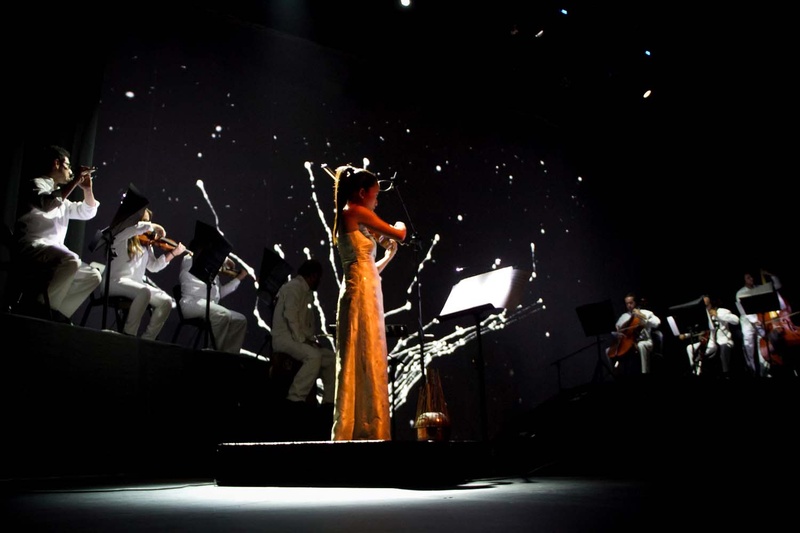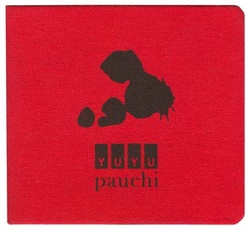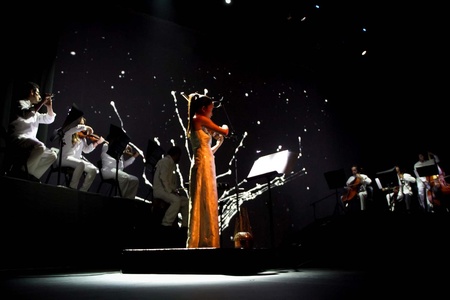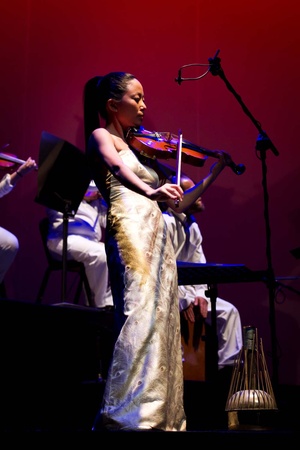His most recurring biography says that he is a classically trained violinist, that he began his studies at the age of five and that he has released two albums as a soloist (“YUYU” in 2007 and “koPpu” in 2011), but to better understand the work he The Peruvian Pauchi Sasaki is dedicated to it. It is necessary to know what her academic training was: Communication Sciences and Arts at the Pontifical Catholic University of Peru.
He studied this career to dedicate himself to journalism for some years, being a correspondent for foreign media, working in the production of channel N and on the website Radialistas de Ecuador, while taking music classes. The recorder and violin from the earliest childhood (two and five years old) formed his decisive vocation for art, culture and forms of expression.
Curiosity and intuition did the rest. He took Andean violin courses at the Music and Dance Center of the Pontifical Catholic University of Peru, Hebrew violin courses in New York, and also completed a master's degree in electronic music at the Oakland University of Liberal Arts. This is all part of the learning and experiences that allowed him to find his own sound, one that perhaps he would not have been able to cultivate in a conventional school.
“I discovered that classic is not my thing, experimenting is part of my life and for that I rely on a strategy. It is the theory of communication: the goal is to connect but there is a sender, a receiver and a message that will form a concept. From there you compose with a predisposition,” says Pauchi, who has made music for commercials, films, plays and fashion shows, adapting to each format.
The language of art
Its sound dialogues with each environment, with each medium. Whether it is a gallery room, like when he put on “Padrecocha”, an audiovisual performance with Andean airs; in an abandoned factory (the collective performance “The Deposit”); at the bus station where he performed an improvisation; or in the bathroom of a clothing store where he soloed for four hours; Sasaki's serious and subtle, dark and melodious, electric and deep violin reveals another language.
Classical sounded lofty, light, and somehow unnatural to him. Pauchi's style immerses itself in textures that not only come from that struggle with herself, from what she calls her “organic and erratic introspection,” but from dialogue with each space and each audience. “It is not the same to play in a bathroom, where the music was a surprise element, than in a warehouse where many were waiting for what could happen, or in a theater, where people's attitude is different.”
Each audience is different. That's why she tries to adapt, especially when composing for others. In 2014 he participated in the Bogotá Book Fair, where he demonstrated the popular musical fusions of Peru, recorded the music for three films (this year he has already embarked on one more) and a series of commercials. “Some people think that advertising is selling out. "I'm happy when they tell me that my sound has gained another color."
Expression without limits
Although she majored in Communication, all the Arts students at her university knew her, to the point that they thought she had studied with them. He became popular in the underground musical circuit of Lima where he played his violin and also on artistic stages, where he attracted attention for his audiovisual presentations. “The communication process does not end in the score, it is a whole, a concept like that of a film script.”
Now he no longer dedicates as much time to rehearsing as he does to putting together the production of presentations such as “In_travestido”, which he directed with Juan Carlo Castillo, “Idiomediatez”, co-directed by Selma Bozanic or, more recently, “Gama XIII”, an audiovisual concert staged at the Peruvian Japanese Theater together with his sister Nomi, in the visual production and live performance of shodo, and which in its previous versions was exhibited at the Cultural Center of Spain and at Casa MATE, the Mario Testino Museum.
“I always try to introduce something new to every performance,” says Pauchi, who has been on stage with musicians and dancers (including butoh actor Kinya “Zulu” Tsuruyama) in Spain, the United States, Japan and other countries. Her latest creation: “The Speaker Dress Wearable Sound Sculpture”, a dress made with speakers that interact with her movements.
Shapes and sounds
Pauchi is a conceptual artist who, in this last stage, seeks to explore rawer sounds through electronic music, always supported by an interdisciplinary team that contributes to bringing a language of shapes and sounds to the stage. “They are not pieces of music,” she says, who always tries to record her presentations on video to give them an audiovisual conclusion.
At the TEDx Tukuy in 2014, in front of a computer, Pauchi Sasaki moved crystal spheres in the air that produced sounds through visual sensors. Two violins (one acoustic, the other electric, created by herself) were waiting their turn. “I don't know what Pauchi is going to make me feel this time,” one of the spectators who were waiting to enter one of his shows remembers responding on television.
Musical or multimedia performance encompasses his concerns, such as the exploration of mental states, which he discovered in the cinema of Andréi Tarkovsky, or the creative versatility, which he admires in the actress Meryl Streep. “Every day is an infinite world, full of possibilities to create,” reflects the visual artist Abel Bentin, protagonist of one of the commercials in which Sasaki was in charge of the sound composition and the filmmaker Claudia Llosa, nominated for an Oscar in 2010, of the direction.
“You have to make an effort but not force yourself,” says the violinist who was inspired by a trip through the jungle and the sicuri, an Andean dance. In the “Metamorfosis” by Ovid and the “Don Juan Tenorio” by José Zorrilla. In landscapes and photography. Improvisation, in a theater, a recording studio or the roof of a mansion, is the format in which the arts that dialogue with the poetics of its four strings are found.
© 2015 Javier García Wong-Kit












